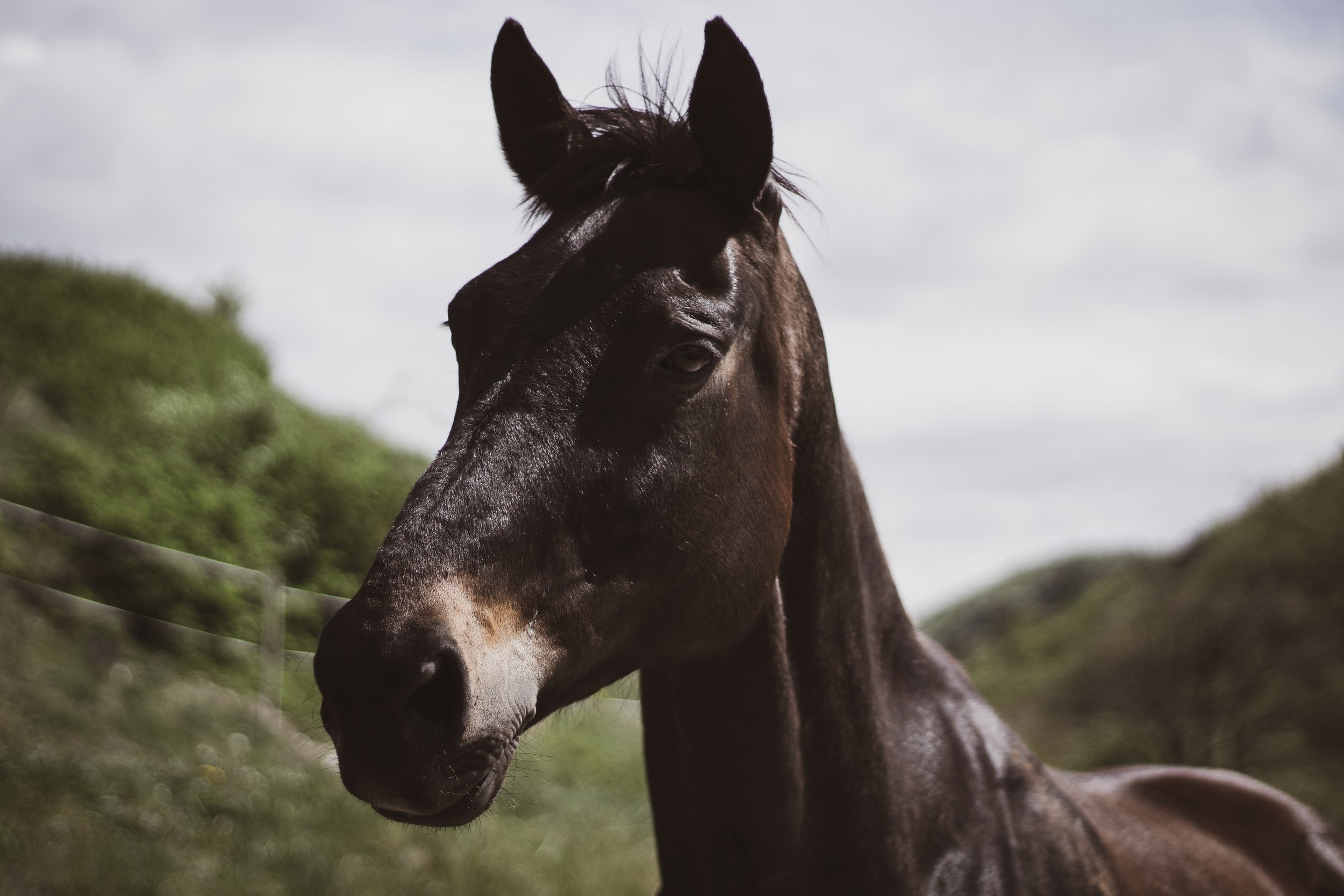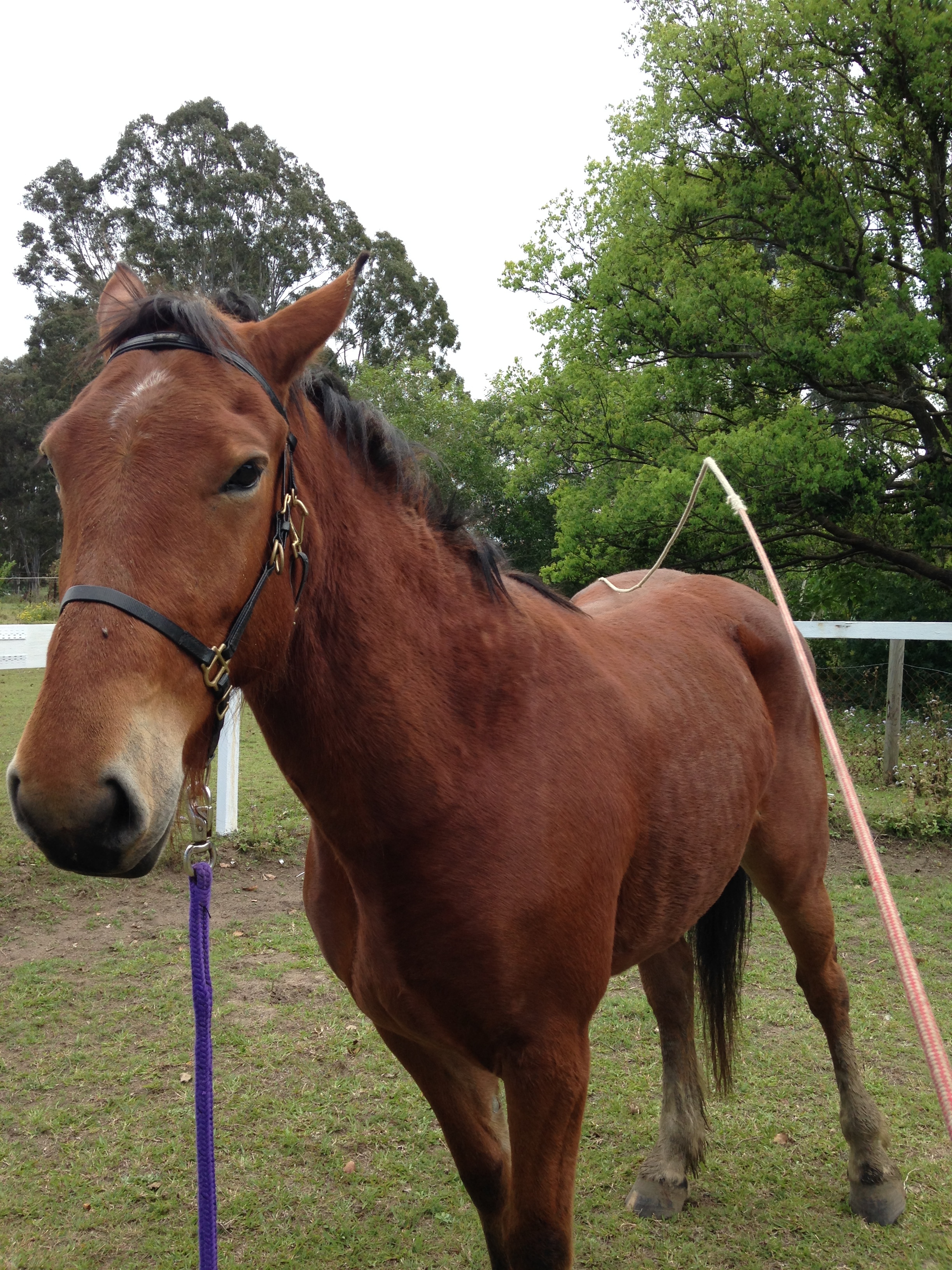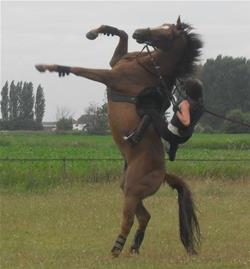Who Wouldn't Want To Train A "Bomb Proof" Horse?
What is the bomb proof horse, and what SHOULD they be?
Ok - so first let me preface this with:
we don’t like the terminology “bomb proof”.
Often when I see horses described as bomb proof, they are malnourished or shut down.
Even when we are working with the truly quiet horses, I believe the term bomb proof puts us in a false sense of security that increases risk of accidents happening.
My experience has been active in training horses to be beginner riding school horses, so we need to get them as quiet as we can. For me it is important to have our horses in peak mental, emotional and physical health as well as a clear understanding of what is expected of them and their cues to be considered “quiet”.
School horses are truly special horses as they need to look after riders that are unbalanced and can unintentionally hurt them when they lose their balance, don’t understand complex aids (the horse knows they can get out of work at any stage) and aren’t strong enough to “bully” them into submission.
In my experience, the quiet “bomb proof” horse isn’t created by sacking them out and desensitising them.
They are created by proving ourselves as competent and trust worthy leaders, building our horses confidence and their understanding. This can make any breed and any temperament of horse “bomb proof” - as long as we rule out other considerations such as pain, medical conditions, ill fitting gear and the like.
Outside of pain or discomfort, the reason a horse might NOT be classified as “bomb proof” include:
The horse not understanding what is needed of them
The horse can’t do what we are asking of them
The horse does not have the confidence in themselves (or their rider) that they are safe/will be kept safe, and this can include any past traumatic experiences.
The horse does not understand how pressure is being used as a tool of communication. (This often starts with the rider/trainer not understanding the timing of pressure/release for the horse to understand it)
The horse doesn’t feel understood. (This is the most common issue I see. Our horses try to communicate with us what they need and we often miss the subtle cues and the horse ends up overreacting and being considered dangerous)
The rider/trainer not knowing when to back off and when to push for more, or expecting too much of the horse
These principles are our guiding factors in establishing the training that Equestrian Movement offers in our online courses:
First do no harm. Ensure that any of the training you are doing moving forward is of no detriment to the horse.
Create a safe and stable learning and living environment.
Create a relationship with our horse where they trust us that not only will we not hurt them but we also won’t put them in a situation where they could be hurt.
Teach them how to learn and understand what we want.
Teach them how to process their emotions and think rather than react.
Teach them confidence
Make learning fun
Make moving fun
Make being ridden fun
Curious to know how we do this? We cover all these in our course Training Trainability.
Reached The Breaking Point? Here is why...
We all have one. Have you found your horses?
All horses have a point where they can no longer say “yes”.
Think about a time a work with your boss where they have given you a job and you say yes can do, and then they give you another 3 jobs to achieve in that same time frame and you say yes can do but in the back of your mind you think “oh that’s getting tight”. They walk back in with a few more tasks to add to the list and all of a sudden your at your tipping point, ready to walk out. Or on the flip side, an anxious mess trying to figure out how you are going to get through all your work.
Here’s another scenario: Have you been given a task that you have finished and handed it in only to be told not good enough? So you’ve taken it back to review and thought “yeah I can tweak that”; handed it back in, and it’s still not good enough. How many times can you be told it’s not good enough, with no recommendations on how to make it good enough, before you stop trying?
These are breaking points. You are pushed to your limits.
How well you cope with this kind of pressure has a lot to do with your passion for the project, your personality and how successfully you have worked through challenges like this before. This is why, with our training, we teach our horses to learn, work through their emotions, and to try and cope with pressure first, before we start giving them tasks like doing well at competitions.
A lot of horses with behavioural problems have those problems because that is the only way they have left to communicate NO.
Ideally I would like the horses not to know that bucking, rearing, bolting, biting and kicking are an option. But often that has already been established by the time I start working with them. So at this point I want to know:
How much pressure they can cope with before they react “negatively”
What behaviour they choose when they hit that breaking point.
What little behaviours and subtle signs they give before reaching that point
What settles them down
Our Training Tools
When we ONLY use negative reinforcement (IE creating an uncomfortable stimuli to illicit a certain behaviour), we will always hit a breaking point in our horse. This becomes an even more frequent occurrence when as the handler we miss our timing for the release of pressure. Using positive reinforcement we can encourage our horse to seek the correct behaviour through incentivising that behaviour with a reward.
At Equestrian Movement we use gentle negative reinforcement through pressure release to establish boundaries for acceptable behaviour and discipline, and then combine this with positive reinforcement for cue training and aids.
This means that now and then we will push our horse for more, but ALWAYS aim to avoid their breaking point by knowing when and how to release the pressure. We most commonly do this when our horse is challenging our authority. So we MUST know what to look for when our horse is about to hit breaking point.
The breaking point
Basically the horse shows resistance, and that resistance grows in intensity.
If we have done our pressure release right and we know our horse knows to seek the release of pressure.
If we have ruled out all other reasons for resistance (ie, pain, not understanding what we want or not being able to do what we want) we have a spectrum of behaviour.
Initially, if our horse is comfortable they will choose to ignore us, or they could also be shut down (read about symptoms of a shut down horse here). There is a very fine line of responsivity before we are putting too much pressure on the horse and they are overreacting. We want to gently find that point of responsivity to find out how much pressure our horse needs to get a response from our ask, without the pressure overwhelming them and making them scared or aggressive.
Just because you’ve gotten your horse to respond to you doesn’t mean that the horse will pick the right response. But getting stronger and increasing the pressure won’t make them choose the right response either. You have to look at your other tools. Is your horse not responding correctly because:
It’s in pain (IE teeth are sharp, saddle doesn’t fit, damaged muscles etc)
It doesn’t understand what you want
It can’t do what you want
It is scared of what you are asking, getting the answer wrong and getting in trouble or what you are asking it to do will cause it pain or for it to do something it doesn’t want to do.
You’ve asked too many times without reward or break
If any of these reasons are the reason for your horse to say no, you will push it to its breaking point and make it over react.
We have covered some simple training rules in our training trainability course to help you avoid reaching that breaking point while still getting the behaviour you want from your horse.
Begin training your horse the CORRECT way
Click here to view the Training Trainability courseHow To Tell If Your Horse Has Shut Down
Did you know that some horses ‘shut down’ their emotions while still doing what is asked?
Did you know that some horses ‘shut down’ their emotions while still doing what is asked?
The stillness that is the result of a tight and tense horse is often mistaken for calmness - until the horse overreacts
When your horse shuts down, it is a coping mechanism for not knowing what is expected of them and being scared of the consequences of doing the wrong thing. What is thought of as your horse being calm and relaxed because they are standing still is actually them choosing to do nothing to avoid the consequences of the wrong behaviour.
When this occurs in training, the horse stops learning and engaging with us and starts trying to protect itself. Rather than them learning how to process the training cues with calm relaxation, they are tight and tense on the brink of being tripped over into a fear state. This stillness that is the result of being tight and tense not knowing what to do is often mistaken for a calm, quiet horse. The horse hits its threshold for what it can cope with and all of a sudden overreacts leaving the owner/trainer saying “where the hell did that come from?”
Being shut down is also like learned helplessness. Learned helplessness is a shut down state but not all horses that are shut down are in a learned helplessness state.
Signs your horse has shut down:
Horse stops responding to whips, spurs and being led by the halter or bridle
The horse is unresponsive to a lot of stimuli (typically called a bomb proof horse) when trainers train desensitisation without training how to process, relax and breath through fear, the horse learns to just not to react to things it is scared of.
Horse is standing perfectly still but standing tense and not breathing deeply. Their posture is guarded, they know where their exits are and ready to run, if there are no exits they will be getting ready to fight.
Horse unexpectedly over reacts like launching into the air, broncing, bolting or lunging out at you with their teeth or legs.
Avoid contact. They don’t try to initiate conversation with you and actively avoid you by not looking you in the eye, not touching you with their nose, standing perfectly still when you pat them and sometimes flinching at your touch.
The horse doesn’t exhibit the normal stress signs because it is like a dissociative state. They have “left the building”, disconnected from their body.
Your horse is often trying to communicate it is uncomfortable when it is shut down before it stops coping. This is why with the way we train we try to encourage our horses to tell us they have a problem before they have a big problem. The signs are often very subtle however and often missed.
It can be the swish of a tail, the stomp of a hoof, the toss of the head, the swivel of the ears. This is where knowing your horse becomes so important and also why we use pressure release the way we do. Your horse can do these things as a little grumble and protest but then chooses to work with you. Other horses will do this as a sign to say back off I’m not coping. Its important to learn how much pressure your horse can cope with before they aren’t coping anymore, what behaviour they show when not coping, how they communicate to back off and what you need to do to help soothe them back into a state of processing cues again.
Over time as your relationship and trust builds your horse should become less sensitive and more willing to your asks but only because they know you are listening to them and respecting their boundaries they allow you to ask more of them.
Using tactics to scare, intimidate and bully horses into submission is a common training tool used today. And, because it works, it continues to be used. It’s how I was initially taught to train. “Be scarier than the thing your horse is scared of”. However, I also learnt to train by teaching beginners who aren’t strong enough, coordinated or savvy enough to get a horse to cooperate through these tactics and so had to find another way they could get their horses to not only do as they asked but also to look after them.
Begin training your horse the CORRECT way
Training Trainability takes you through the methods to avoid your horse shutting down - click here to learn moreLooking for more specific content?
Have a question you are seeking answers to? Send us a message and we will create a blog!






